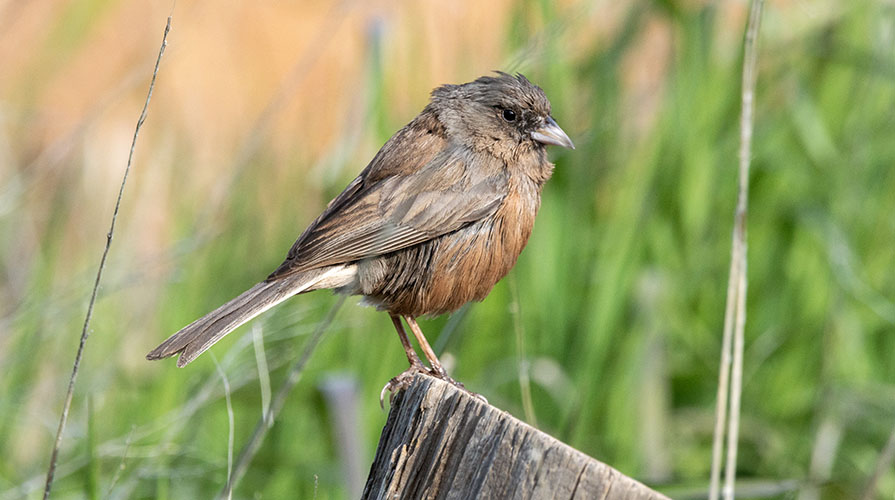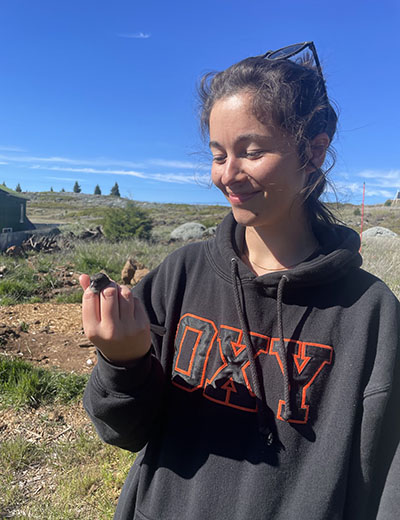
Alana Pizarro joined a fieldwork expedition to Isla Guadalupe, a wind-swept island off the coast of Baja California. The researchers were studying the Guadalupe Island Junco, a small sparrow with unique evolutionary characteristics and a delicate existence.
Alana Pizarro paused next to a few research colleagues amid the enormous pine trees, taking in the scene. On a remote island nearly 200 miles west of the Mexican mainland, they had been hiking through brush and over rocks for several miles. Now they stood, enveloped by quiet and overwhelmed by the feeling of being in a truly natural space where few humans ever go.
“It was such a stunning sight and it felt like an immense privilege to be able to see this kind of thing,” Pizarro says.

She was on Isla Guadalupe with John McCormack, professor of biology and director of the Moore Lab of Zoology at Occidental, joining Tenured Research Scientist Borja Milá and three other researchers from Spain’s National Museum of Natural History. They were there at the invitation of collaborating researchers from Grupo de Ecología y Conservación de Islas (GECI), a Mexican nonprofit dedicated to studying and preserving the island’s unique and fragile birdlife, from species as large as the Laysan albatross to the tiny, endangered Guadalupe Island junco.
“My goal was essentially to become a sponge,” Pizarro says. “It was my first time going out in the field, so there were so many new skills to learn. It was such a great opportunity to be totally immersed in this field as a very early professional.”
Refining her path
Growing up in Pasadena, Pizarro started her college career on the opposite coast, attending New York University. But she soon realized the more intimate, personalized setting of a small liberal arts college would suit her better. She transferred to Oxy and “absolutely loved it.”
A biology major, Pizarro was interested in animal welfare and planned to attend veterinary school. To that end, she got a part-time job as a vet tech. But she also took on an internship at a wildlife rehab hospital called the California Wildlife Center. Working primarily with injured birds, the experience sparked an interest that led her to enroll in McCormack’s Avian Biology class at Oxy.
She began coming to the Moore Lab regularly to take bird specimen measurements for a research paper for her class. McCormack noticed her dedication and offered her a summer position at the lab following her junior year. As a senior, she worked as a collections assistant and continued her research independently.
Pizarro’s motivation propelled her to acceptance at the American Ornithological Society’s annual conference in 2022, where she presented her research, which was eventually published in the journal Ecology and Evolution. Resolving a “mild crisis,” she finally decided to abandon the vet school plan and follow her growing passion for bird research with the Moore Lab, where she was hired full-time after graduation. Today, she maintains the lab’s research collection in addition to managing the Genomics Center.
La Isla Bonita
Twenty-two miles long by seven miles wide, Isla Guadalupe was formed by volcanic activity about 8 million years ago. The island is carefully protected conservation land and access is strictly limited by the Mexican government. Authorized visitors hitch a ride with the Mexican Navy on a decommissioned US Navy ship from World War II.
“We were on the boat for 36 hours,” Pizarro says. “We slept on the completely open deck, just rolled out our sleeping pads. When we arrived, they threw a wood-and-rope ladder down the side of the ship and we just clambered down.”
Once on the island, the researchers met up with colleagues from GECI, staying in their field station amid pine and cypress forests on the north side of the island. During their five-day stay, Pizarro and her colleagues had the goal of “mist netting” as many Guadalupe juncos as they could.
“You catch birds in a net and then record a bunch of data, put numbered bands on them so that if they're recaptured, you can go back to your previously collected data and do some cross-referencing, and then release them,” she says. “It's a relatively low-stress method of collecting a lot of data from a living organism.”
We were on the boat for 36 hours. We slept on the open deck, just rolled out our sleeping pads. When we arrived, they threw a wood-and-rope ladder down the side of the ship and we just clambered down.
Back in the lab, Milá’s group will analyze the data along with blood samples to learn more about these birds’ genetics. It was Milá’s fifth time on the island, so there is data from previous years to compare population density and potential genetic shifts.
Pizarro says that the experience made her very happy about the path she’s on.
“I love working at the Moore Lab. I'm getting so much research experience, but also lab experience that I think most people that only have a bachelor's would probably not be able to get.”
She’s also excited by the idea of applying to graduate school and getting a doctorate in evolutionary biology, ecology, ornithology, or museum science.
“This trip definitely helped affirm that next step.”
